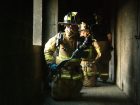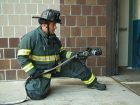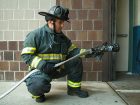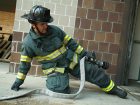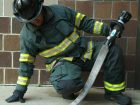
Features
Structural
Training
Back to Basics: June 2018
In our look back at the last 10 years, there has been a lot of attention devoted to moving the handline. There has been a paradigm shift in the fire service due to firefighters like Aaron Fields, Andy Fredericks, Dave McGrail and others. This article was written back in 2008 when the paradigm started to take flight.
May 18, 2018
By Mark van der Feyst
■ Engine Company: Hose Advancement, November 2008
Last edition we looked at the importance of the backup person on the hose line when we are advancing a hose line into a structure. Hose advancement is an important part of our fire ground operations. Without it, we are unable to conduct interior operations. There is a saying in the fire service regarding hose advancement, “As the first line goes, so goes the fire!” What does this mean? It means that if we are able to advance our initial hose line correctly and efficiently from the start, our fire will follow suit. If we advance our initial hose line incorrectly and completely mess the operation up from the start, our fire will quickly go downhill from that point.
Part of hose advancement is knowing how to advance the hose from the nozzle man’s position. Many times, we incorrectly advance hose from this position. Let us look at two methods of advancing a hose line from the nozzle man’s position.
In our basic training, we have been taught to advance a hose line from the kneeling position, with both of our knees on the ground. See photo 1. We have always shown recruit firefighters that this is the way to advance hose. Even during live fire training, I have witnessed this time and time again. Every person on the hose line is on their knees, both of them crawling along trying to advance a hose line. Is this efficient and practical? No, it is not efficient and practical. In fact it slows down the hose line being advanced and it creates more work for the team.
So why do we do this? I believe we teach this method because we assimilate hose line advancement with search. We teach our recruit firefighters to search on their hands and knees which can also be inefficient and sometime useless. This basic method is ingrained into their heads and so they are taught the same method for hose advancement (we will look at proper search techniques later in the year). We also teach this method for safety reasons. If we are on our knees, we will be low to the ground and below the heat. As nice as this sounds, it leads to an unsafe practice.
Advancing a hose line as in photo 1 will lead you to certain doom. How many times do we read of firefighters falling through floors while advancing a hose line? It just happened this year in Ohio where two died while advancing a hose line inside a residential house. Crawling on your knees will lead you to the open holes in the floor or open stairs and when you come upon them, it will be too late, and you will fall through and down. It has happened with one of my recruits in a burn tower during live fire training. The recruit fell down a set of stairs because he lost his balance while on his knees, and when he came upon the set of stairs, he fell right down to the bottom.
I categorize this as the “penguin walk”. Penguins walk upright with little movement of their feet. They fall over easily because they are top heavy. We also are top heavy when we crawl on both of our knees. Look at photo 1 again. If this firefighter were to come upon a hole in the floor, how will he know it is there? When he comes upon it, he will fall right through because his whole upper body is top heavy. Remember we are wearing full SCBA on our backs; we have equipment in our hands, in our pockets, a helmet on our head, a radio in our upper pocket, a flashlight and a face piece on our face. All of this equipment adds to the overall upper weight of our body. He will have no chance of recovery.
How can we avoid this? We can advance our hose lines by having our one leg out in front of us. See photo 2 for this point. In the photo, you will see how the firefighter has his one leg out in front of him. By doing this he will be able to advance the hose line a lot faster and with ease. Notice the span that is covered by advancing in this fashion. If we were to advance our line on both of our knees, our span is very limited
We are also able to feel the floor in front of us with the front leg. This will give us an early warning that there is a hole in the floor or an open set of stairs. We can also recover and prevent ourselves from falling in. Look at photo 4. The firefighter can fall back to prevent falling into a hole. This is accomplished because his upper body weight is resting mostly on the back leg.
Another advantage of advancing a hose line in this fashion is the ability to absorb the nozzle reaction. If you were to be by yourself on the nozzle and your back up man was a little ways away (because he is helping to bring in more hose for you around corners) you would be able to handle the nozzle reaction better. Remember in the previous article regarding nozzle management we discussed the proper way of managing the nozzle. This position forces you to hold the nozzle the correct way and not on your hip. Crawling on your knees allows you to hold the nozzle in the wrong position which is on your hip.
It also allows to you to be more aware of your surroundings. When you are crawling on your knees, you are only going to see what is in front of you. If you are on your hands and knees, it will be even more difficult to see what is going on around you. In the position of photo 2, you will be able to see what is going on around you. You will have more mobility to observe.
I observed a student at a training evolution in September at a live fire class. He was crawling on his knees to advance the hose line. His partner was anxious to get the hose fed to him. He was actually pushing the first firefighter over because he was pushing the hose toward the firefighter and because the first firefighter was on his knees, he was thrown off balance from behind by his own man. Advancing the hose line as in photo 2 will avoid this.
Another way of advancing the hose line is seen in photo 3. Instead of having the one leg out in front, we can duck walk. The same objectives can be accomplished as in photo 2. We can cover a great distance because our span will be more than crawling on our knees. Our upper body weight is also resting on our back leg. If we come across any openings in the floor we will be able to recover ourselves and prevent falling through. Look at photo 5. This positional stance of advancement will aid you in setting yourself up to employ the tactics of nozzle management.
Using the hose line to “feel” the floors or walls in front of you can be beneficial. This tactic can save your life. It has worked in the past. I know of a firefighter in Ohio who used the hose line to “feel” the floor in front of the team and discovered that there was a hole in the floor. Sweeping the nozzle stream across the floor in front of us will aid us in feeling if there is any floor in front. It will also help to cool off the floor for you as you advance into the structure. Burning material that falls to the ground from the ceiling can burn your knees. Sweeping the floor will cool it and make life easier for you in the long run. We can also use the nozzle stream to “feel” the walls for windows or any other openings. A great way of extending our reach!
What has been described here will only work if we practise and train these techniques. By doing so, you will master the skills shown and it will become an instinctive manoeuvre to execute.
Mark van der Feyst has been a member of the fire service since 1999 and is a full-time firefighter in Ontario. Mark teaches in Canada, United States and India, and is a FDIC Instructor. He is the lead author of the Residential Fire Rescue book. Email Mark at Mark@FireStarTraining.com.
Print this page
